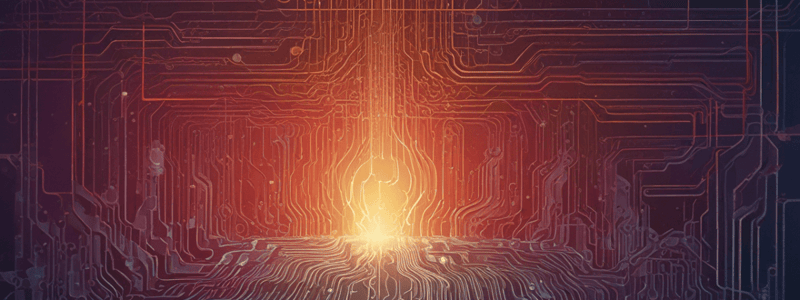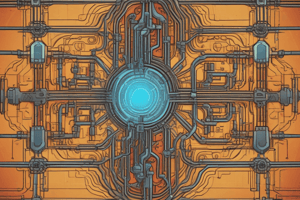Podcast
Questions and Answers
What is the primary function of a resistor in an electric circuit?
What is the primary function of a resistor in an electric circuit?
- To increase the flow of current
- To act as a switch and control the flow of current
- To provide energy to the circuit
- To convert electrical energy into other forms of energy (correct)
What type of electrons carry electric charge in metals?
What type of electrons carry electric charge in metals?
- Bound electrons
- Stationary electrons
- Static electrons
- Delocalized electrons (correct)
What is the purpose of a switch in an electric circuit?
What is the purpose of a switch in an electric circuit?
- To increase the voltage in the circuit
- To open or close the circuit, controlling the flow of current (correct)
- To reduce the resistance in the circuit
- To decrease the current in the circuit
What is required for an electric circuit to function?
What is required for an electric circuit to function?
What is the term for the flow of electric charge through a conductor?
What is the term for the flow of electric charge through a conductor?
What is the primary function of a conductor in a circuit?
What is the primary function of a conductor in a circuit?
What component of a circuit provides energy to the circuit?
What component of a circuit provides energy to the circuit?
What is the term for the pathway that allows the flow of electric current?
What is the term for the pathway that allows the flow of electric current?
What is the purpose of a switch in a circuit?
What is the purpose of a switch in a circuit?
What happens when a circuit is open?
What happens when a circuit is open?
What is the purpose of the negative terminal of a cell?
What is the purpose of the negative terminal of a cell?
What is a characteristic of a series circuit?
What is a characteristic of a series circuit?
What happens when one component fails in a series circuit?
What happens when one component fails in a series circuit?
What is a characteristic of a parallel circuit?
What is a characteristic of a parallel circuit?
What happens when one component fails in a parallel circuit?
What happens when one component fails in a parallel circuit?
What is the result of a closed circuit?
What is the result of a closed circuit?
What is the primary function of an energy source in an electric circuit?
What is the primary function of an energy source in an electric circuit?
What is the term for the electrons that carry electric charge in metals?
What is the term for the electrons that carry electric charge in metals?
What is the purpose of a load in an electric circuit?
What is the purpose of a load in an electric circuit?
What is necessary for an electric current to flow through a circuit?
What is necessary for an electric current to flow through a circuit?
What is the term for the movement of electric charge through a conductor?
What is the term for the movement of electric charge through a conductor?
What type of pathway is necessary for an electric current to flow?
What type of pathway is necessary for an electric current to flow?
What is the purpose of a conductor in an electric circuit?
What is the purpose of a conductor in an electric circuit?
What is the result of connecting a source of energy to a circuit?
What is the result of connecting a source of energy to a circuit?
What is the primary function of a light bulb in a simple circuit?
What is the primary function of a light bulb in a simple circuit?
What is the result of a break in the pathway of an electric circuit?
What is the result of a break in the pathway of an electric circuit?
In a series circuit, what happens to the current if one component fails?
In a series circuit, what happens to the current if one component fails?
What is the purpose of a wire in a simple circuit?
What is the purpose of a wire in a simple circuit?
What is the difference between a conductor and an insulator?
What is the difference between a conductor and an insulator?
What is required to build a simple circuit?
What is required to build a simple circuit?
What is the characteristic of a parallel circuit?
What is the characteristic of a parallel circuit?
What happens when you close the switch in a simple circuit?
What happens when you close the switch in a simple circuit?
Which of the following is NOT a type of component in an electric circuit?
Which of the following is NOT a type of component in an electric circuit?
What is the primary function of a conductor in an electric circuit?
What is the primary function of a conductor in an electric circuit?
What type of energy is converted by a load in an electric circuit?
What type of energy is converted by a load in an electric circuit?
What is necessary for an electric current to flow through a circuit?
What is necessary for an electric current to flow through a circuit?
What happens when a source of energy is connected to a circuit?
What happens when a source of energy is connected to a circuit?
What is a characteristic of delocalized electrons?
What is a characteristic of delocalized electrons?
What is the purpose of a terminal in an electric circuit?
What is the purpose of a terminal in an electric circuit?
What is the result of having multiple components in a circuit?
What is the result of having multiple components in a circuit?
What is the main difference between a conductor and an insulator?
What is the main difference between a conductor and an insulator?
What is the purpose of the light bulb in a simple circuit?
What is the purpose of the light bulb in a simple circuit?
What happens when a switch is open in a circuit?
What happens when a switch is open in a circuit?
What is a characteristic of a series circuit?
What is a characteristic of a series circuit?
What is necessary to build a simple circuit?
What is necessary to build a simple circuit?
What is the result of a closed circuit?
What is the result of a closed circuit?
What is the purpose of the wires in a simple circuit?
What is the purpose of the wires in a simple circuit?
What is the characteristic of a parallel circuit?
What is the characteristic of a parallel circuit?
What is the primary function of a delocalized electron in a metal?
What is the primary function of a delocalized electron in a metal?
What is the purpose of a conductor in an electric circuit?
What is the purpose of a conductor in an electric circuit?
What is the primary function of a switch in a circuit?
What is the primary function of a switch in a circuit?
What is the primary function of a load in an electric circuit?
What is the primary function of a load in an electric circuit?
What is necessary for an electric current to flow through a circuit?
What is necessary for an electric current to flow through a circuit?
What is the term for the movement of electric charge through a conductor?
What is the term for the movement of electric charge through a conductor?
What type of pathway is necessary for an electric current to flow?
What type of pathway is necessary for an electric current to flow?
What is the result of connecting a source of energy to a circuit?
What is the result of connecting a source of energy to a circuit?
What is the primary characteristic of a material that allows it to be used as a conductor in an electric circuit?
What is the primary characteristic of a material that allows it to be used as a conductor in an electric circuit?
What is the main difference between a series circuit and a parallel circuit?
What is the main difference between a series circuit and a parallel circuit?
What happens to the current in a circuit when the switch is closed?
What happens to the current in a circuit when the switch is closed?
What is the primary function of a light bulb in a simple circuit?
What is the primary function of a light bulb in a simple circuit?
What is the result of a break in the pathway of an electric circuit?
What is the result of a break in the pathway of an electric circuit?
What is the primary function of the wires in a simple circuit?
What is the primary function of the wires in a simple circuit?
What is the characteristic of a conductor that allows it to be used in a circuit?
What is the characteristic of a conductor that allows it to be used in a circuit?
What happens when a component fails in a parallel circuit?
What happens when a component fails in a parallel circuit?




